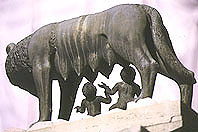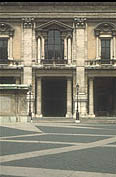Campidoglio Area
Capitoline Museums
(Musei Capitolini in Palazzo dei Conservatori). Up the flight of stairs: on the first landing are 4 magnificent deep friezes from Triumphal Arches mounted against a vibrant yellow background. Three are of Marcus Aurelius and the one on the right a Sacrifice to Jupiter at his temple on this hill - the Capitoline.
Room I is vast with frescoes from the 16C, and 2 large statues of Popes.
Room II is also frescoed, and here starts the collection of both ancient Roman and Greek statues. Admire the deeply carved wooden doors separating these Papal chambers (1643).
 Room III. Junius Brutus 3C BC Bronze head. Though perhaps not of him after all, this head with ivory and glass eyes has a look of veracity. It was stuck on a 16C bust. Spinario, 1C BC Bronze. The famous statue of a young Greek boy pulling a thorn from his foot. Both of these pieces came from Pope Sixtus IV's donation, in the 15C.
Room III. Junius Brutus 3C BC Bronze head. Though perhaps not of him after all, this head with ivory and glass eyes has a look of veracity. It was stuck on a 16C bust. Spinario, 1C BC Bronze. The famous statue of a young Greek boy pulling a thorn from his foot. Both of these pieces came from Pope Sixtus IV's donation, in the 15C.
Room IV. La Lupa, 5C BC, the She-Wolf Bronze. Another famous statue, probably Etruscan, it depicts the legend of Rome's founding. - the wolf who suckled Romulus and Remus. However they were added to this sculpture 2000 years later by Antonio Pollaiolo, in that curious Renaissance custom of embellishing an existing work. Don't miss the mosaic floor; not old but so attractive.
Room VII. Room of the Tapestries. Made by street children of 16C and 17C who were scooped up, and taught an art or trade.
Room XV. Bust of Commodus as Hercules, 2C AD The effete likeness of Emperor Commodous stares vacantly, his hair Pompadoured, with a lion skin over his head - not messing up one curl.
"Esquiline Venus", 1C BC marble. A priestess of the Temple of Isis, small and beautiful.
Room XXIV. Hall of the bronzes. A large head of Constantine or perhaps his son Constantius II, and an exquisite antique Roman bed, reconstructed from separate fragments. It doesn't look too comfortable.
Room XXV. All the ancient goodies discovered in Maecenas' garden. The head of his friend Augustus, the first Emperor (27 BC), is interesting.

The painting collection (Pinacoteca) is another floor up. There are 10 rooms of mostly religious paintings from 15-17C, with some works by famous painters including Veronese, Tintoretto, Rubens, Velasquez, which has recently been beautfully renovated.
On the right at the entrance is the long Galeria Cini with an extraordinary collection of historic porcellain.
On the left in the Sala Petronilla with Guercino’s enormous masterpiece, the burial and apotheosis of St. Peter’s daughter, St. Petronilla.
There are also two Caravaggios:
- "The Palm Reader", 1595. The young man half listens as the pretty girl tries to get his attention - and his ring!
- "St. John the Baptist", 1602. Profane and sensual. Michelangelo was the first to depict St. John as a young man. Caravaggio, however, went further, painting him nude and at play with a ram.
New Wing. More ancient Roman discoveries. Especially interesting are:
Room 3. Statues of 3 Emperors: Claudius, Domitian, and Trajan.
Room 13. Bust of Faustina, (faithless) wife of Antonius Pius. Bust of Sabina, ignored wife of Hadrian.
![]() Our Favorite: imagining the huge Constantine statue reassembled, and residing again in the huge Basilica in the Roman Forum.
Our Favorite: imagining the huge Constantine statue reassembled, and residing again in the huge Basilica in the Roman Forum.
Open Tuesday through Saturday 9 am - 7 pm. Sunday 9 am to 6,45 pm. Closed Monday. Free admission last Sunday of month